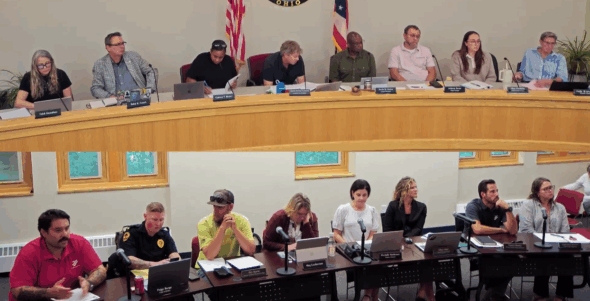
Present for the first budget session, Oct. 3, were, from top left: Council members Trish Gustafson, Brian Housh, Carmen Brown, Gavin DeVore Leonard, Kevin Stokes, Village Manager Johnie Burns, Assistant Village Manager Elyse Giardullo and Village Clerk Judy Kintner; Bottom from left: Department heads Brad Ault (water/wastewater), Police Chief Paige Burge, Ben Sparks (water/electric distribution), Village Planning and Economic Development Director Meg Leatherman, Finance Director Michelle Robinson, finance consultant Tiffany Hiser, Tanner Bussey (streets) and Samatha Stewart (parks and rec). (video still)
2026 budget sessions begin with projected $512k deficit
- Published: October 19, 2025
The Village of Yellow Springs may be up against a significantly unbalanced budget for 2026.
Though municipal discussions are still underway and budgetary cuts are already being made, the Village’s General Fund, as of press time, is projected to operate in 2026 with a deficit of around $512,000.
For next year, Village expenses are expected to total $5,365,902, while revenues are projected at $4,853,812.
If the Village’s spending continues outpacing its revenue at the same rate, the deficit may grow to nearly $800,000 in 2027.
According to Village documents, the dip in municipal revenue stems from less grant funding being available for capital improvement projects throughout town, reduced earnings from the Village’s investments as well as the rising costs of physical materials to complete infrastructure improvements. Of its expected revenues for 2026, Yellow Springs aims to collect $1,257,914 in property taxes and $2,516,438 in income taxes.
Fortunately, the Village still has time to skirt the grim possibility of an unbalanced budget for 2026. Already, local leaders and department heads have met and have reduced the projected deficit for 2026 from an earlier estimation of $820,000.
The first of two scheduled budgetary meetings took place Wednesday, Oct. 3, when Village Council members joined forces with Village staffers to figure out what to cut, what projects to put on hold and how, ultimately, to reduce deficit spending for years to come.
Village Finance Director Michelle Robinson led the session, and began by noting that the forecasted budget for 2026 would be the first deficit budget in five years. She also pointed out that the budget, as drafted, assumes the passage of the upcoming Village levy renewal, which would collect $855,477 annually over five years.
The General Fund — which pays for essential Village services and provides transfers to other areas, such as streets, parks and capital improvements that do not generate enough funding on their own — was Robinson and Council’s primary focus Oct. 3.
Department heads were invited — Samantha Stewart of parks and recreation, Tanner Bussey of the streets crew, Brad Ault of water and wastewater treatment, Ben Sparks of water and electric distribution and Police Chief Paige Burge — and each was charged with pitching their department’s top three priorities for the coming year.
Their presentations to Council covered quite a bit of ground.
According to the five department heads, the pool needs to be painted, the youth center could use some new flooring, curbs need to be replaced, the streets are cracking, park water fountains are in disrepair, pipes need servicing, a new water well could be drilled, the switch station needs rehab, water valves need to be replaced, the Bryan Center needs new security cameras and the police need a new cruiser and more modern tasers — just to name a few department requests expected to seek support from the General Fund in the coming year.
Following those numerous budgetary requests, Council members weren’t yet inclined to say “no” or to suggest cuts from any department.
“I would like to see some kind of capital comparison to see what it would look like to punt some of these projects, because I’m not sure I’m ready to cut any of them,” Council member Brian Housh said.
Council member Trish Gustafson encouraged department heads to return to the drawing board.
“This is the time to take a hard look,” she said. “It’s not easy to do, but we’re forced to do it.”
Gustafson also panned the camera out and said she’s worried about budgeting for the coming year with the passage of the upcoming levy as a foregone conclusion.
“From what I’m hearing in the community, this levy is at risk,” she said. “There are so many unknowns, groceries are expensive, everything is going through the roof. I don’t think we’re preparing enough for that possibility. I would hate to see people laid off.”
“If the operating levy doesn’t pass, then we’ll be in crisis mode,” Housh said earlier.
At another point in the budget discussion, Council members and staff bemoaned the apparent lack of grant funding to carry out capital improvement projects.
“Everyday, we are working to find grants — and grants are slowing and drying up for infrastructure,” Village Manager Johnnie Burns said.
“Right,” Council Vice President Gavin DeVore Leonard agreed. “We had a generational massive influx that came in from the previous [presidential] administration.”
Other than information sharing among the different arms of Village government, no material decision was made at the Oct. 3 budget session. However, in the weeks since, the projected deficit deflated by about $300,000, down from $820,000 — the number Council and staffers wrestled with at their meeting — to $512,000.
Finance Director Robinson later told the News, a sizable portion of the deficit was made up by withholding some funds planned for the streets department.
As she noted Oct. 3, the initial transfer from the General Fund to that department was going to be $625,000 — over a $400,000 increase from the 2025 budget. Before the cut following the first budget meeting, the street fund was expected to deficit spend by just over $180,000.
Despite that and other anticipated cuts made to some of the Village departments, Robinson and others insisted that current municipal staffing levels will remain consistent through the budgeting process and into 2026.
“The biggest piece for our expense side isn’t our personnel,” Tiffany Hiser, a consultant from the Shared Resource Center, told Council. “Notwithstanding any big shifts, it’s whether or not we get the capital projects done, or whether or not any more capital projects land on our plate. Those are the types of things that ebb or flow, sending folks significantly over or under budget.”
Not only will all staffers continue working for the Village under the eventual 2026 budget, but Council and administrators are angling toward including a 3% cost-of-living increase for Village employees.
The next budget meeting is scheduled for Wednesday, Oct. 15 — two days ahead of the News’ publication date — with Council members charged with making the case for the Village financing Council-sponsored initiatives such as Fourth of July fireworks and support for local organizations like the YS Senior Center and YS Home, Inc.
Also to be considered Oct. 15 is a piece of legislation that, if passed, will authorize the village manager to enter into an agreement with a contracted agency to conduct a review of payroll practices — presumably in the interest of a future cost-of-living increase for municipal workers.
Village Council is anticipated to give a second reading to the final iteration of the 2026 budget, alongside a public hearing, at the group’s Nov. 10 meeting.
The News will continue to provide updates on the budget as they are made available. The next regular Village Council meeting will be held Monday, Oct. 22, at 6 p.m. A work session regarding TIFs and CRAs will be held immediately before at 5 p.m.
The Yellow Springs News encourages respectful discussion of this article.
You must login to post a comment.
Don't have a login? Register for a free YSNews.com account.













No comments yet for this article.